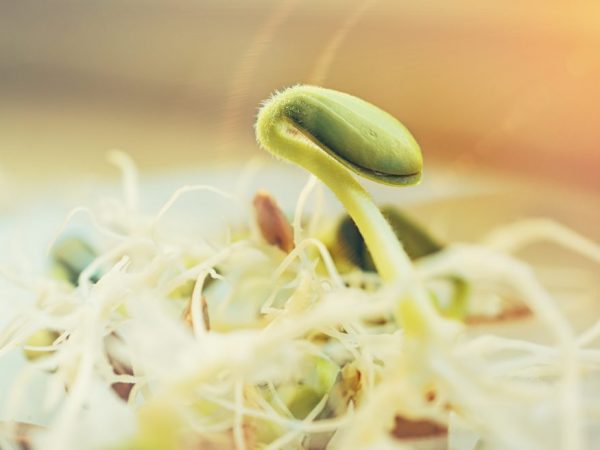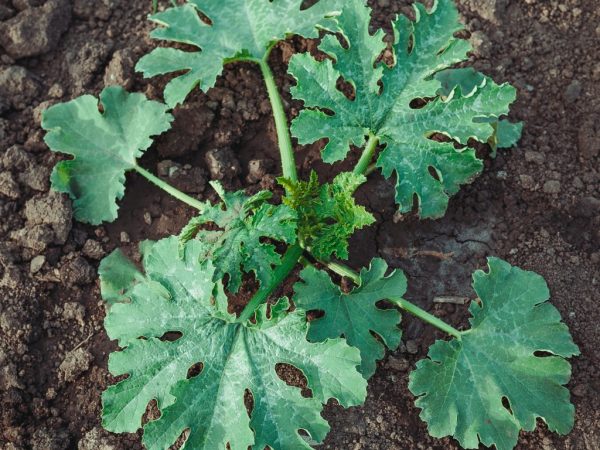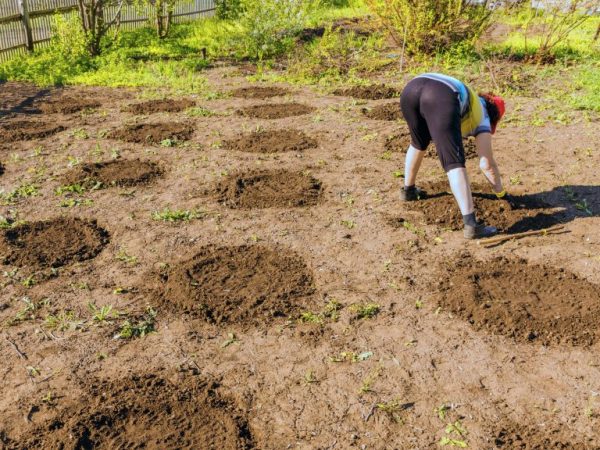Features of planting zucchini
Planting zucchini in open ground has a number of features. Good yields are guaranteed by planting vegetables on time, pre-preparing the planting material, choosing the right place for growth, choosing the right technology and providing proper care.

Features of planting zucchini
When to plant zucchini
The correct timing of planting zucchini will ensure the normal development of vegetable crops and a good harvest.
- Planting procedures begin at the moment when warm weather sets in and night frosts stop;
- To get an early harvest, it is worth picking up early varieties that have a shortened germination and ripening time (it is possible to plant as early as April). If you intend to keep fresh vegetables for the winter, they give preference to varieties with late fruiting (they start planting in May);
- Many gardeners use the lunar calendar additionally to calculate the planting time, determining favorable days, while the days of the full moon and new moon are unfavorable.
Sowing zucchini seeds gives a positive result when the soil warms up to a temperature of 12 ° and above.
Recommendations
It takes about 20-30 days to grow seedlings according to the norms. This time is taken into account when preparing future seedlings for the next transplant into the garden or greenhouse.
It is recommended to germinate seedlings in separate containers - plastic or peat cups, some use cut plastic bottles.
Seed preparation
To accelerate germination, you first need to prepare the seeds for planting zucchini. You can use one of the following options:
- for 4-6 hours they are kept in water heated to 50 ° C, then for quenching they are immediately placed in cold water for 1-2 minutes;
- 1 day is kept in a growth stimulator, then washed under running water, dried and immediately planted;
- the inoculum is soaked for 12 hours in a nitrophoscope;
- keep the seeds in a damp gauze cloth (leave them until they swell), sow after they hatch.
Basic landing rules
Recommendations for planting zucchini in open ground:
- Choose a loose fertile soil, preferably black soil or light loamy, well fertilized with organic matter.
Attention! Acidic, clayey and excessively moist peat soil is not suitable;
- The soil is prepared in the fall, harrowing with a rake, activating the growth of weeds, and after 2 weeks it is dug to the residual depth, burying the weeds. At the same time, fertilizers are applied - 1 bucket of compost, 30 g of superphosphate and 30 g of potassium per m².
- In the spring, before planting, they dig up the soil to a depth of 0.2 m, adding 20 g of saltpeter to it for each m². A bucket of sand and a bucket of peat chips are additionally mixed into the clay soil.In a sandy one - 1-2 buckets of dry clay.
Zucchini are planted in beds, having previously formed furrows with a shovel bayonet and making holes at a distance of 0.6 m. Between the ridges, with further care, a distance of 1 m or more is maintained.
Organic matter mixed with earth is introduced into the formed holes, pouring them with warm water. Planting depth:
- in light soil - by 6-7 cm;
- in heavy - by 3-4 cm.
2-3 seeds are placed in each hole in order to choose the strongest of them later. At the end, they are covered with soil and tamped. To avoid crusting, the soil is mulched with a peat mixture, humus or straw.
Regional features of cultivation

Seedlings are planted in the ground depending on the terrain
Planting zucchini is planned depending on regional characteristics.
- In central Russia, sprouted seedlings are planted in open ground, starting at the end of May. Seed material can be sown from the first days of April until the last days of the month, while varieties of different intensity of ripening are suitable for cultivation.
- In areas with a cool climate and a short summer season (for example, in the Urals and Siberia, the Moscow and Leningrad regions), vegetable crops are cultivated mainly by the seedling method, so it is worth planning the sowing of seeds 30 days in advance, germinating the seedlings and only then replanting them. This usually occurs at the end of May - beginning of June, with preference given to early and mid-season varieties.
Landing table by region:
| Region | Duration of sowing seeds and planting seedlings |
| North Caucasian | From early to mid-May |
| Rostov, Lower Volga region | 2nd and last third of May |
| Moskovsky, Middle Volga region, middle lane | 2nd and last third of May |
| Leningrad, Pskov, north-west, Ural, Siberia | End of May - beginning of June |
Table of popular varieties with different ripening periods:
| Name | Maturation characteristic | Productivity in kg / m² |
| White Swan | Early ripe | 9 |
| Zolotinka | Early ripe | 5 |
| Golda | Early ripe | 5,7 |
| Tsukesha | Early ripe | 12 |
| Orange miracle | Mid-season | 5 |
| Caruso | Mid-season | 7 |
| Walnut | Late maturing | 8 |
| Cellar | Late maturing | 8 |
Correct predecessors and neighbors
Before planting zucchini in open ground, it is worth considering the previous crops. Good compatibility with:
- potatoes;
- carrots;
- beets;
- greens;
- onions.
The best joint neighbors, which also look beautiful in the beds, are dill and mustard. They are planted between holes or between rows.
Planting in a place where pumpkins, cucumbers and squash were previously grown is not recommended - these vegetables take from the soil that mineral nutrition, which is similar in components to the nutrition for zucchini. Due to the poverty of the land, they grow much more slowly.
Planting technology of Galina Kizima
The method of planting bush zucchini by Galina Kizima says that the seeds are not preliminarily subjected to any processing and are not soaked.
According to the scheme, sowing goes into funnels made in the garden in unripe compost. The holes are located at a distance of 0.45 m. Preference should be given to bush forms of vegetable crops.
If the soil under the compost heap has not warmed up, the funnels are spilled with hot water in the amount of 1/3 of a bucket.
The seed hole is not covered with earth. The beds are covered with foil. In case of an accidental onset of frost, the planting can be additionally covered with lutrasil, lined on arcs.
Throughout the growing season, not a single feeding is carried out, because the compost retains the nutrients it needs. The film is not removed from the plantings, it retains the necessary moisture, the plants are not additionally watered.
Landing methods of Oktyabrina Ganichkina
Growing a vegetable crop using Ganichkina's technology involves planting by seedlings, which makes it possible to get an early harvest, starting in July.

In warm regions, the seeds are planted immediately into the ground.
Zucchini seeds are planted in the second half of April.Seedling germination takes 25-30 days, after which it is transplanted into open ground. The best time is early in the morning or on a cloudy warm day.
The garden bed is fertilized with a nutrient mixture Exo (200 g), nitrofosky (1 tsp), the Energen stimulator (1 ampoule per 10 l).
Dig up the soil and make holes at a distance of 0.6-0.7 m.
The plantings are covered with foil, which is removed after June 12-15. Watering is carried out regularly, under the root system, without wetting the foliage.
Top dressing is carried out twice:
- before the beginning of the flowering stage with the fertilizing complex Agricola (1 tablespoon per 10 liters of water);
- during the budding period with the fertilizing complex Effekton-O (2 tablespoons), mixed with wood ash (2 tablespoons per 10 liters).
Zucchini shade
It is best to plant in sunlit places, zucchini grow well and develop on the southern slopes.
In the shade, on the north side of the site, they grow more slowly, flowering is not so abundant, which affects the amount of the crop.
It is not necessary to choose an area next to which groundwater flows as a place, which, together with shading, often causes vegetables to rot.
What to plant after zucchini
Vegetable crops have no significant effect on the fertility of the soil.
The main requirement: do not plant crops that are prone to the same diseases and require the same nutrients as zucchini.
Cucumbers and pumpkins are not suitable, because these are closely related vegetable crops. Watermelon, melon and strawberry grow poorly.
Often planted:
- tomato, for which the predecessor creates a well-loosened soil;
- garlic and onions, which effectively disinfect the soil;
- legumes that restore nitrogen levels.
Peppers, cabbage, radishes, carrots, potatoes, beets and eggplant are also suitable.
Care basics
To obtain a rich harvest, zucchini are planted at the time set for different regions, pre-preparing the seeds, observing the basic rules of planting and care.
How to care for zucchini:
- watering is provided regularly, once every 7 days, in dry periods - up to 3 times, while using warm water at room temperature, watering the soil surface;
- hilling seedlings is carried out when 5-6 leaves appear on them;
- top dressing is applied initially after 10-14 days after sowing the seeds, secondly - at the flowering stage, the third fertilization is carried out during the formation of vegetables, mineral compositions are used as baits;
- as weeds appear, at least once a week, the soil is loosened, which ensures the supply of moisture and air to the root system;
- after the beginning of flowering, insects are artificially attracted for pollination, which helps vegetables to tie, they do this with the help of diluted honey, which is sprayed on the foliage near the ovaries;
- to prolong the fruiting stage, ripe vegetables are plucked as they appear;
- empty flowers that have not set into fruits are cut off, which saves the plant's resources for the ripening of the set vegetables;
- in early spring, plantings are treated against pests and infections, and the procedure is repeated when signs of infection appear.

